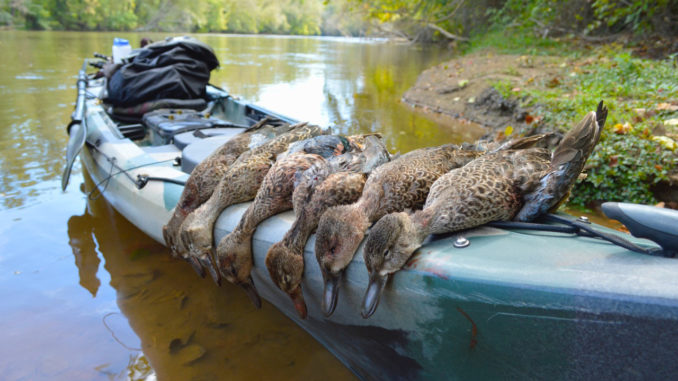
Last week’s weather brought loads of little ducks into area for Saturday hunts
If often seems that North Carolina’s waterfowl seasons are too early or too late to match up with migrating waterfowl. The birds stall up north due to warm weather or push south in between the staggered seasons, so hunters can’t get to them. But the short opening segment of the season opener broke the mold and put hunters on the Yadkin River right in the middle of the early season migration.
The four-day season began Oct. 1, and he first three days were typical: few birds and predominantly wood ducks. This past Saturday, Oct. 4, was a different scene as migrating birds showed up, apparently during the night.
At first, it seemed like a fluke. A band of blue-winged teal peeled out of the canopy of a fallen tree along the river bank and whirled skyward. They turned downstream, then upstream, and eventually landed back where they started. As the day wore on the pattern repeated over and over again.
Hunters reported seeing hundreds of ducks in roughly 20-bird flocks all across the upper portion of the Yadkin – extremely unusual because the majority of migrating birds never come west of Raleigh. Friday’s weather front may have helped push birds south and west enough to change that pattern.
Teal are the first migrators to reach North Carolina each year. They fly south to Florida and are the last waterfowl to head north again the following spring. Small birds, weighing roughly a pound, they are known as fast flyers.
Many hunters were confused by the flocks of “all hens.” The drakes are known for their winter breeding plumage, consisting of a black head with a white stripe in front of their eyes. They don’t change into these characteristic feathers until after October, which means most of the birds won’t have these looks until after they leave the Old North State.
Instead the males and females both have similar brown feathers and heads. Both sexes also have the bright blue speculums, the bar of feathers at the bottom of each wing. Hunters can tell the two apart by looking at more subtle features like the feet. Males have bright orangish-yellow feet like a mallard. The females have brownish feet like a female wood duck.
If the October season is any indication, hunters might be in for a memorable season when it reopens Nov. 8.




Be the first to comment